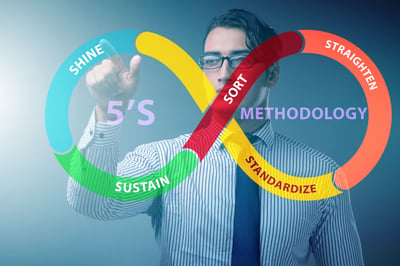 The 5S workplace organization technique is a prevalent methodology that companies can use to improve operations. The intent is to improve efficiency, minimize waste, and generally optimize how things are run. The 5S technique is most often used in manufacturing and warehousing organizations, but it can significantly benefit almost any industry. Learning the principles of 5S will help your organization gain its benefits and implement it with great success.
The 5S workplace organization technique is a prevalent methodology that companies can use to improve operations. The intent is to improve efficiency, minimize waste, and generally optimize how things are run. The 5S technique is most often used in manufacturing and warehousing organizations, but it can significantly benefit almost any industry. Learning the principles of 5S will help your organization gain its benefits and implement it with great success.
The 5 S’s
5S may seem like a strange name for a workplace organization strategy, but the name has meaning. It comes from the fact that there are five areas where improvements to the working environment can be made. The technique originated in Japan, so the five categories were originally given Japanese names, all of which happened to start with the letter S. They’ve been translated into English, also with “S” names for the sake of consistency.
The 5 S’s are:
- Sort – Anything that isn’t required for performing operational tasks should be removed from the area. Eliminating unnecessary items serves to eliminate clutter so that everything that is needed can be more easily accessed.
- Set – Setting things in order means ensuring that each item in the workplace has a specific location where it is stored. Doing so minimizes the risk of something getting lost or misplaced and ensures that things aren’t damaged because they aren’t properly stored.
- Shine – Keeping equipment, tools, and the facility in good working order eliminates many potential problems. Tasks associated with shine include regular maintenance, cleaning, and repairing items that need attention.
- Standardize – Every workplace should have standards in place that everyone follows. Standardization involves defining ownership of various assets and tasks to help make the work environment predictable.
- Sustain - Sustaining workplace organization is the most challenging step of all, so it gets its own category. Sustaining improvement should not be an afterthought. There must be a plan to revisit each of the other four items and a person (or people) who own the responsibility.
In addition to these five categories, some organizations include ‘Safety’ and consider it a sixth S. When this is included, the system is sometimes called 6S or 5S + Safety. While the other 5s are things that you do. Safety is something that can be achieved when they are well executed.
5S Checklists
As we mentioned, maintaining the 5S methodology can be a challenge. Knowing the concepts behind each of the S’s is essential, but putting it into practice takes some effort. 5S checklists are an excellent tool for finding things that are not in compliance with 5S and fixing them. A 5S checklist is also a useful tool for auditing a facility and making improvements where needed.
Managers or operators can take a checklist that includes the various 5S items and go to the Gemba (the place where work is done). They can identify anything that is not 5S compliant and document it so that it can be fixed or improved later. When performing a 5S review, it is beneficial to take a close look at every step of each process and task to ensure all improvement opportunities are identified. Doing so regularly will help facilitate continuous improvement and serve to sustain gains as they are made.
Benefits of Adopting 5S
Implementing 5S takes effort and resources, so it is crucial to understand what benefits you will gain. Many benefits, such as fewer defects, reduced maintenance, and repair costs, and a more pleasant place to work, are apparent, but some are unexpected.
For example, an organization that uses the 5S methodology will find that their productivity can increase significantly. This improved efficiency is made possible because many of the obstacles that slow people and systems down have been eliminated or mitigated to allow operations to flow more smoothly.
Waste reduction is another significant benefit. By improving operations, there are fewer defects and more efficient use of all resources. Finally, one of the commonly overlooked advantages of 5S is the improvement in employee engagement and satisfaction. 5S empowers employees to make improvements to their workspace, which benefits the company and allows employees to do their best work.
Implementing 5S is a smart move for any company that is looking to improve process operations. It is straightforward and inexpensive to implement, and if sustained over the long run, it can ensure the company gains advantages that grow over time.
![[Watch Now] Effective Collaboration Across Organizations & Industries](https://no-cache.hubspot.com/cta/default/326641/3a0a5daa-031f-47e3-a055-891d1f640e2e.png)
![[Watch Now] Components of an Employee-Led Lean Initiative](https://no-cache.hubspot.com/cta/default/326641/a91195a9-a959-420e-b46f-d1a97a8175ba.png)


Add a Comment